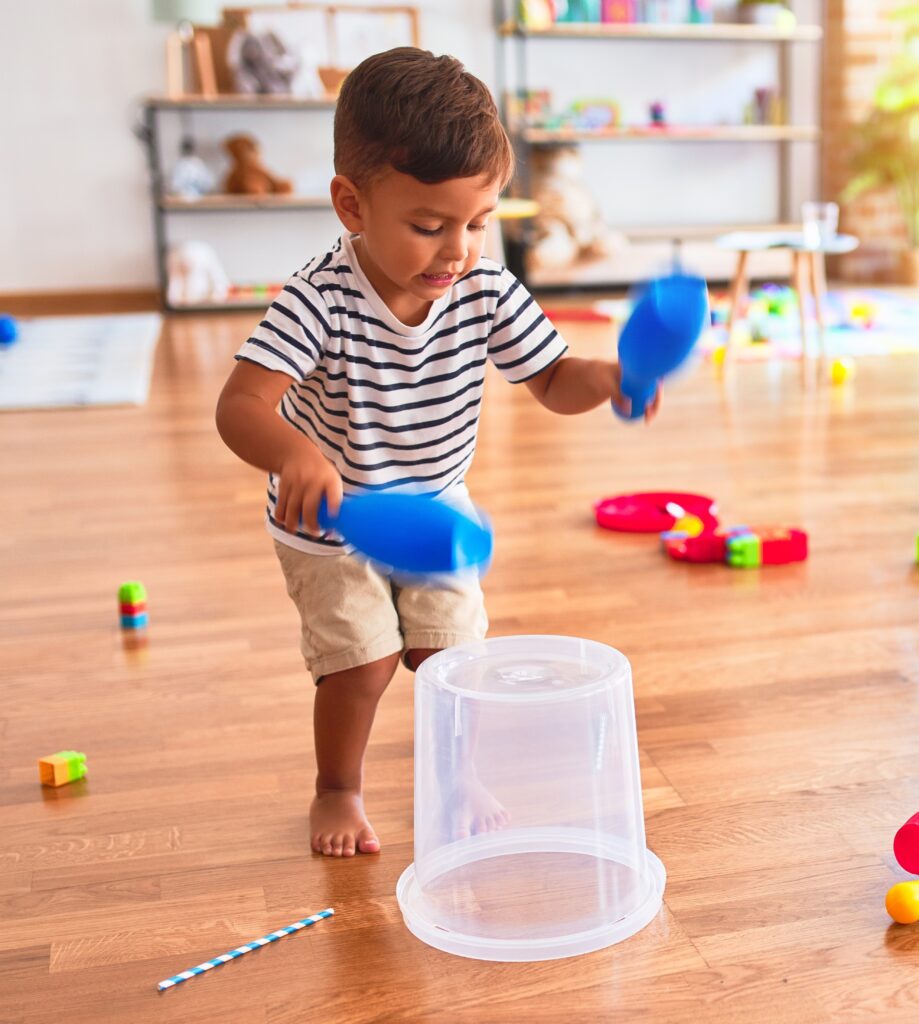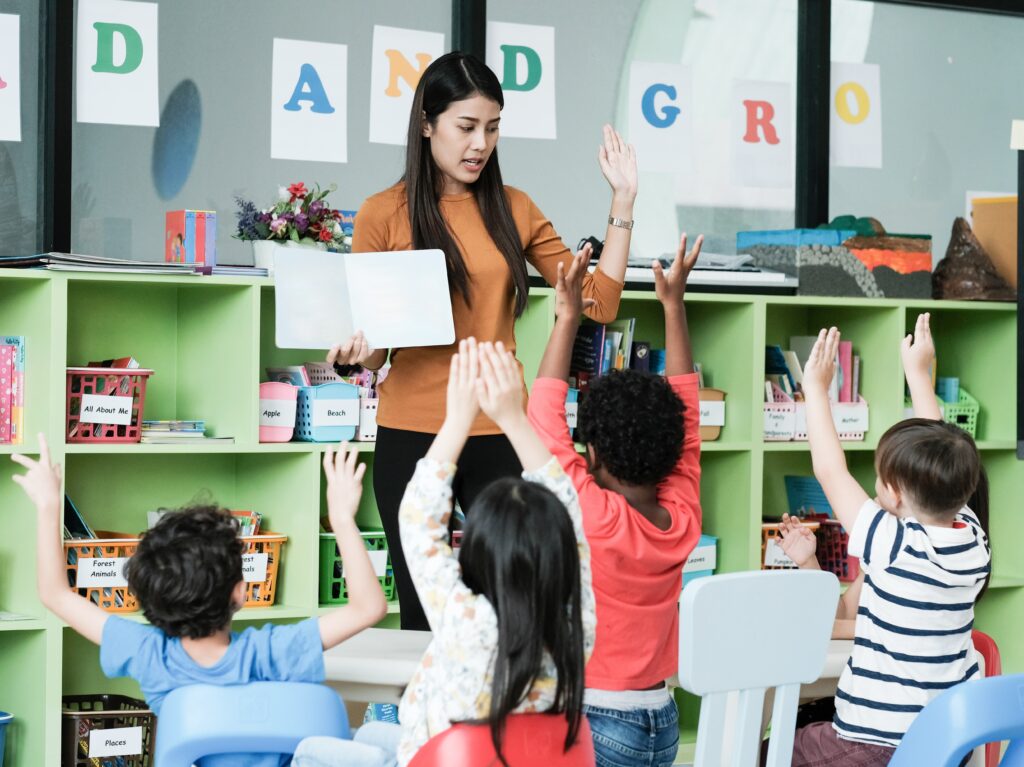10 Joyful Activities that Boost Young Children’s Development
December 11, 2024
We could all use a little more joy in our lives—and the activities in today’s post will help you infuse more fun and positivity into your routines with young children. They’ll also help kids learn and practice important social-emotional, language, motor, and problem-solving skills. Try these at home or in your classroom, and share them with parents of young children!
 Strike up a band. This is a great way for children to have some noisy fun with friends while practicing gross motor and communication skills. Have children chant or sing a nursery rhyme and tap it out on a drum, the bottom of a pot, or a small box. Then make the activity more challenging and interesting by adding more instruments, such as bells, spoons, or shakers.
Strike up a band. This is a great way for children to have some noisy fun with friends while practicing gross motor and communication skills. Have children chant or sing a nursery rhyme and tap it out on a drum, the bottom of a pot, or a small box. Then make the activity more challenging and interesting by adding more instruments, such as bells, spoons, or shakers.
- Adapted from ASQ®:SE-2 Learning Activities & More by Elizabeth Twombly, Leslie Munson, and Lois Pribble
Make “happy badges.” Ask children to think about a time when they had a problem and thought about it in a way that made them feel better. Talk about the power of positive thinking. Then have children color a happy badge that will remind them to think positively when they have problems in school or at home. (See the social-emotional learning curriculum Strong Start—Pre-K for some great activities on positive thinking and more.)
- Adapted from Strong Start—Pre-K by Sara A. Whitcomb & Danielle M. Parisi Damico
 Sing a picture book. Try singing all or a portion of one of your favorite picture books. Select one with rhythm, rhyme, and repetition, and either borrow a melody or make up one of your own. Singing a book promotes early literacy skills and provides the added benefit of supporting emotional regulation. The experience of listening to the book as it’s sung and gazing on the illustrations helps children self-calm and be present in the shared book experience.
Sing a picture book. Try singing all or a portion of one of your favorite picture books. Select one with rhythm, rhyme, and repetition, and either borrow a melody or make up one of your own. Singing a book promotes early literacy skills and provides the added benefit of supporting emotional regulation. The experience of listening to the book as it’s sung and gazing on the illustrations helps children self-calm and be present in the shared book experience.
- Adapted from Sing & Sign for Young Children by Anne Meeker Watson
Have a race with the cleanup clock. Can cleanup time be joyful? We say yes! Try setting a timer and have your children race the cleanup clock: “I wonder how fast you can put away your toys. I’ll time you. Are you ready? On your mark, get set, go!” (If a timer may make a child anxious, you can also use a flashlight for a gentler variation: “I’ll shine the light on what you can put away next.”) Helping out is an important social skill to master, and quick games like these can make it easier for both you and your kids.
- Adapted from ASQ®:SE-2 Learning Activities & More by Elizabeth Twombly, Leslie Munson, and Lois Pribble
 Play with rainbows. Colorful rainbows bring joy and capture young imaginations. There are lots of different ways to play with them, inside and outside. Learn a rainbow-themed song with children, like “I Can Sing a Rainbow,” “Des Colores,” or “Somewhere Over the Rainbow.” Make rainbows with prisms or a spray of water from a hose. Create a rainbow paint set by putting a dollop of white glue into each cell of an egg carton, adding a drop of one or more colors of food coloring to each, and mixing with cotton swab “paint brushes.” Experiment with mixing the different colors of the paint rainbow.
Play with rainbows. Colorful rainbows bring joy and capture young imaginations. There are lots of different ways to play with them, inside and outside. Learn a rainbow-themed song with children, like “I Can Sing a Rainbow,” “Des Colores,” or “Somewhere Over the Rainbow.” Make rainbows with prisms or a spray of water from a hose. Create a rainbow paint set by putting a dollop of white glue into each cell of an egg carton, adding a drop of one or more colors of food coloring to each, and mixing with cotton swab “paint brushes.” Experiment with mixing the different colors of the paint rainbow.
- Adapted from Talk to Me, Baby! by Betty Bardige
Do a ribbon dance. For some fun motor skills practice, cut brightly colored ribbon or streamers into 6-foot lengths and show children how to dance and make designs in the air with the ribbons. Try circles and loops, up and down movements, and figure eights. Try the movements with two ribbons, one in each hand. Move from place to place taking the ribbons with you. Then put on some music to make a “ribbon dance.” Encourage kids to skip, run, and walk!
- Adapted from the ASQ-3 Learning Activities by Elizabeth Twombly and Ginger Fink
 Serve up joy and fun during mealtime. When it comes to increasing a child’s motivation to interact with new foods, incorporating fun can be a game-changer. Have children conduct a “treasure hunt” in their soup to find different foods to interact with. Encourage kids to arrange food into fun shapes or arrange ingredients into a smiley face on their plate. And make the most of special interests—for example, if a child is interested in cars, try using (clean) toy vehicles in lieu of utensils. (Find many more ideas in the new book Meaningful Mealtimes!)
Serve up joy and fun during mealtime. When it comes to increasing a child’s motivation to interact with new foods, incorporating fun can be a game-changer. Have children conduct a “treasure hunt” in their soup to find different foods to interact with. Encourage kids to arrange food into fun shapes or arrange ingredients into a smiley face on their plate. And make the most of special interests—for example, if a child is interested in cars, try using (clean) toy vehicles in lieu of utensils. (Find many more ideas in the new book Meaningful Mealtimes!)
- Adapted from Meaningful Mealtimes by Yev Veverka, Susan A. Ramage, Christy Baker, Kelsey Milne, & Emilie Dupont
Tell some funny tall tales. Kids will love the humor of this activity, and it’ll sharpen their language and literacy skills at the same time! Begin by reading stories with children that rely on imagination and exaggeration, such as And to Think That I Saw It on Mulberry Street or Tar Beach. Then, take turns telling your own tall tales together. Start with a simple story, such as “Today on the playground we found a frog.” Take turns adding to the story to make it more and more fantastic and funny!
- Adapted from Talk to Me, Baby! by Betty Bardige
Make a gratitude book. This sweet project will help children strengthen social-emotional, fine motor, communication, and problem-solving skills. Print out photos of special people in the child’s life who make them happy. Let the child arrange and glue the pictures onto sheets of paper, and help them staple the pages together or tie them with ribbon. Give them supplies they can use to decorate the book: glitter pens, sequins, stickers, bits of shiny paper, pictures cut from old greeting cards and magazines. When the book is done, look at it together and talk with the child about the special people who love them.
- Adapted from ASQ:SE-2 Learning Activities & More by Elizabeth Twombly, Leslie Munson, and Lois Pribble
 Share the joy. This activity invites children to share happy moments in their life. Give each child pencils and paper and ask them to remember one of the happiest moments of their lives. They can draw a picture or write a few words. Next, each child comes up with a brief description of the memory, and the others listen and are encouraged to ask questions. Through this activity, kids can relive a happy moment and experience the positive emotions related to it. They can also reflect on their emotions while they retell their stories, and gain insight into others’ feelings.
Share the joy. This activity invites children to share happy moments in their life. Give each child pencils and paper and ask them to remember one of the happiest moments of their lives. They can draw a picture or write a few words. Next, each child comes up with a brief description of the memory, and the others listen and are encouraged to ask questions. Through this activity, kids can relive a happy moment and experience the positive emotions related to it. They can also reflect on their emotions while they retell their stories, and gain insight into others’ feelings.
- Adapted from The Social Emotional Learning Toolbox by Kathy Perez





Write a Comment
Your email address will not be published. Required fields are marked *
Post a Comment